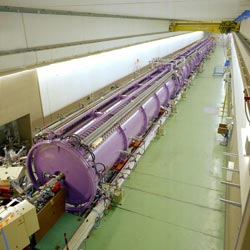Protection for humans on Mars

Cosmic radiation is produced with the GSI linear accelerator.<br>
For six weeks the rover „Curiosity” is now working on Mars. NASA also plans to send humans to Mars within the next 20 years. On the flight and during the stay on Moon or Mars the astronauts have to be protected against long exposure to cosmic radiation that might cause cancer.
On behalf of the European Space Agency ESA the GSI Helmholtzzentrum für Schwerionenforschung GmbH tests whether Moon and Mars regolith can be used to build shieldings for ground stations.
On Earth the atmosphere and the magnetic field weaken cosmic rays. But on Moon and Mars they pelt down unhamperdly. The cosmic radiation can harm astronauts and could cause cancer in the long run as a result of damage in DNA and cells.
Chiara La Tessa is manager of experiments in GSI biophysics. She explains why Moon or Mars ground stations would not be built from terrestrial high tech material: “In space travels every gram counts. Transporting building material through space would lead to a cost explosion. That is why ground stations would basically be built from Moon and Mars regolith – especially the shielding. We know from the analyses done by rovers what the local sand and stones consist of. With this information one can produce Moon and Mars regolith on Earth and we test it for its properties.” As cosmic rays are nothing else but fast ions that were accelerated by star explosions they can be simulated by an accelerator. The GSI facility is one of the few able to reproduce cosmic rays in an original way.
After the GSI team tested how well the stone slabs can protect against radiation in the American accelerator laboratory in Brookhaven, they now explore how many neutrons are produced in the materials when radiated.
If cosmic rays strike the stones with full speed they smash some atomic nuclei to pieces. The resulting free neutrons have a different effect on the human body than cosmic radiation. Depending on their speed they might even be more harmful.
At GSI the scientists now tested how strong the neutron effect is in Moon and Mars regolith and how far it passes through the material. „I cannot estimate how the material is going to react to the radiation yet“, says La Tessa. „Will many neutrons be produced? How many fast and how many slow ones? This we will know when we analyzed our experiment data.“
The tests funded by ESA were coordinated by Thales Alenia Space Italia. The prime contractor of ESA’s project also designed the test plan in cooperation with GSI, chose the materials and evaluats the results.
Media Contact
All latest news from the category: Physics and Astronomy
This area deals with the fundamental laws and building blocks of nature and how they interact, the properties and the behavior of matter, and research into space and time and their structures.
innovations-report provides in-depth reports and articles on subjects such as astrophysics, laser technologies, nuclear, quantum, particle and solid-state physics, nanotechnologies, planetary research and findings (Mars, Venus) and developments related to the Hubble Telescope.
Newest articles

Recovering phosphorus from sewage sludge ash
Chemical and heat treatment of sewage sludge can recover phosphorus in a process that could help address the problem of diminishing supplies of phosphorus ores. Valuable supplies of phosphorus could…

Efficient, sustainable and cost-effective hybrid energy storage system for modern power grids
EU project HyFlow: Over three years of research, the consortium of the EU project HyFlow has successfully developed a highly efficient, sustainable, and cost-effective hybrid energy storage system (HESS) that…

After 25 years, researchers uncover genetic cause of rare neurological disease
Some families call it a trial of faith. Others just call it a curse. The progressive neurological disease known as spinocerebellar ataxia 4 (SCA4) is a rare condition, but its…





















